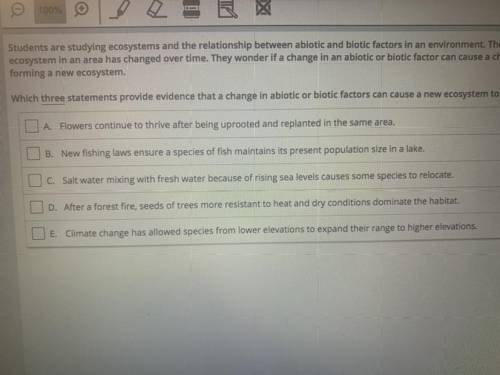
Biology, 10.02.2021 14:00 maddynichole2017
Students are studying ecosystems and the relationships between abiotic and biotic factors in an environment. The students find that the ecosystem in an area has changed over time. They wonder if a change in an abiotic or biotic factor can cause a change in the ecosystem forming a new ecosystem. Which three statements provide evidence that a change in abiotic or biotic factors can cause a new ecosystem to form?


Answers: 3


Another question on Biology

Biology, 22.06.2019 16:00
Which of these outcomes is a negative impact of postindustrial societies on the environment? a. nomadic ways b. overpopulation c. overgrazing d. resource renewal
Answers: 3

Biology, 22.06.2019 16:30
You will create a molecular clock model for an arthropod gene. follow these guidelines to make your model: . your timeline will span from 90 million years ago to the present. the common ancestor in your model is an arthropod that lived 90 million years ago. the gene that you'll track codes for a protein in the species venom . the dna sequence youll track contains 10 nitrogen bases. you can choose the order of the bases and where the mutations occur. this gene mutates at a rate of approximately 0.76 base pairs every 17.1 million years. to build your model,/ calculate the estimated time period it takes for 1 base pair to mutate. the first time period will only show the common ancestor. at the beginning of the second time period, three lineages will diverge from the common ancestor, each with a different mutation in their gene sequences. the first and third descendant species will survive for the rest of the timeline. the second descendant species was extinct 50 million years ago. calculate how long it will take for one full base pair mutation to occur. explain your reasoning by constructing a mathematical equation
Answers: 2


Biology, 23.06.2019 03:50
The pea aphid, a type of insect, contains light-capturing pigments in its exoskeleton. pea aphids gained the ability to synthesize these pigments from genes transferred from fungi. while pea aphids do not have chloroplasts or fix carbon, researchers have found that pea aphids with more pigments have higher levels of atp than those with fewer pigments. pea aphids also have been shown to increase production of atp when exposed to sunlight. based on this information, is the pea aphid a true autotroph? a. yes, because the pea aphid can store energy from the sun in atp molecules. b. no, because the pea aphid is unable to use the energy from sunlight. c. yes, because the pea aphid does not need to use energy from food. d. no, because the pea aphid does not store energy from the sun as sugars.
Answers: 2
You know the right answer?
Students are studying ecosystems and the relationships between abiotic and biotic factors in an envi...
Questions


Mathematics, 26.02.2020 02:04

History, 26.02.2020 02:04






Mathematics, 26.02.2020 02:04

Biology, 26.02.2020 02:04

History, 26.02.2020 02:04



Computers and Technology, 26.02.2020 02:04






Mathematics, 26.02.2020 02:05



